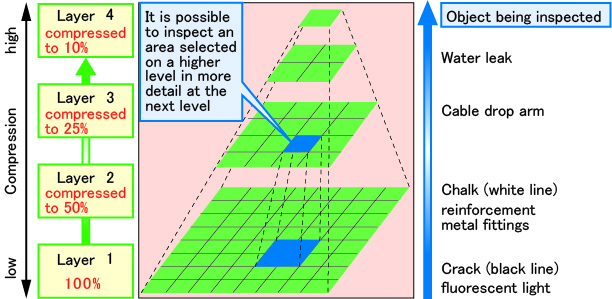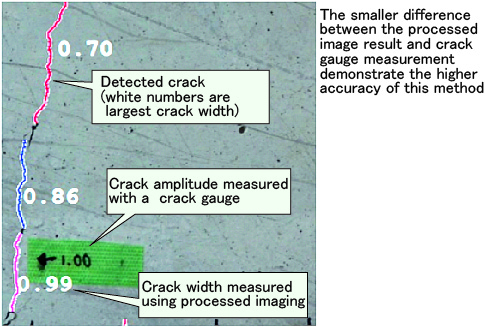6. Higher precision concrete structure inspection using image processing
- A crack detection method was developed using different resolution images and controlling noise influence.
- The developed method makes crack detection possible even to the untrained eye.
- By tracing the crack from its origin it is also possible to estimate its progression.
The latest demands in image processing technology for concrete structure inspection are to have a higher level of accuracy in establishing the condition of the concrete and also to gain more information about the state of progression of that condition. The method below was developed to offer a higher degree of accuracy compared to currently used techniques.
After first preparing the original images by resolution, a proposal was made for multilayered resolution imaging which compresses the images to be used to a degree suited to the object being examined (Fig.1). For example, when a low resolution image is sufficient to detect the object, high compression not only reduces the noise but also increases processing speed. Furthermore, the image processing parameters which determine crack detection performance were set by trial and error in traditional methods. Therefore, as set of basic values were obtained by using a standard concrete surface, in order to improve crack detection performance, and these were used as fixed parameters. Having removed the need for on-site adjustment of the parameters, it is now possible for a person with less experience to carry outcrack detection work (Fig.2). The conventional method for monitoring crack progression has been to superimpose a previous image with a later image. However, differing conditions in which images are taken and shifts in image position requiring correction are a problem. A method was therefore developed to track crack progression by focusing on the crack extremities in the axial direction (Fig.3).

Fig.1 Layered image produced with multi-resolution images
Fig.2 Result of crack inspection using optimal parameter values
Fig.3 Crack progression measurement without using the layered imaging